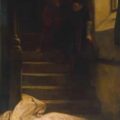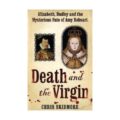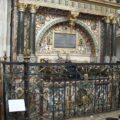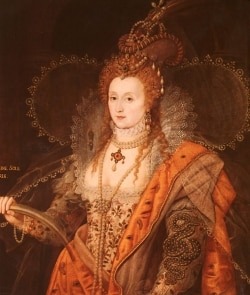
The programme featured the following experts:-
- Philippa Gregory, author of many historical novels including “The Virgin’s Lover”
- Tracy Borman, historian and author of “Elizabeth’s Women”
- Sarah Gristwood, historian and author of “Elizabeth and Leicester”
- Steven Gunn, historian
- Chris Skidmore, historian
- Edward Impey, archaeologist
- Dominic Taylor, architect
- Allen Anscombe, forensic pathologist
- Simon Adams, historian and author of “Leicester and the Court”
The Implications of Amy’s Death
Both at the start and end of the programme, it was suggested that Amy Robsart’s death changed the course of English history because it made Elizabeth into the Virgin Queen. As a result of Amy’s death, Elizabeth did not marry and the Tudor dynasty was brought to an end.
Elizabeth and Dudley’s Relationship
Sarah Gristwood spoke of how Elizabeth made Robert Dudley her Master of the Horse when she came to the throne and that this meant that he was in charge of all the fun things and that when he arrived to see her it was always with “an invitation to play”.
It was suggested that Dudley was Elizabeth’s “surrogate” husband and that in the first two years of her reign Elizabeth was besotted with him. She arranged for him to have a bedchamber next to hers, she spent all of her time with him and this led to scandal and rumour. Dudley was seen as a poor choice and a unsuitable consort because both his father and grandfather were executed as traitors, and William Cecil thought that England would face a very dark future if Elizabeth was to marry Dudley. Also, Dudley was married to Amy Robsart.
Dark Whispers
In 1560 there were “dark whispers” at Court. In March 1560 it was rumoured that Dudley was going to divorce his 28 year old wife, who he had not seen for over a year, and William Cecil told of how Elizabeth and Dudley were trying to get rid of Amy. By September 1560, the Court was alive with rumours, Elizabeth seemed so obsessed with Dudley that she was seen to be abandoning her country, Dudley was gaining power and influence, and William Cecil was at his wit’s end. Cecil told the Spanish ambassador that he saw ruin for the Queen if she continued the way she was going.
The Death of Amy Robsart
Amy Robsart died on the 8th September 1560 at the house she was renting in Oxfordshire, Cumnor Place. She was found dead at the foot of the stairs. According to the programme, her death had all of the ingredients of an Agatha Christie thriller and it was used in Walter Scott’s 1821 romantic novel, Kenilworth, where Amy is murdered by Dudley’s steward, Sir Richard Varney. At the time, at the inquest into Amy’s death, the coroner ruled that her death was down to “misfortune”, an accident .
The Stairs
Cumnor Place was pulled down in 1810 so the stairs that Amy was said to have fallen down no longer exist. However, archaeologist Edward Impey was able to build a model of Cumnor Place based on old drawings and plans and concluded that Amy must have lodged in the Great Chamber. Architect Dominic Taylor made a 3D model of the staircase shown in an old plan of this part of the house and concluded that although it was a dangerous staircase, in that it twisted half-way down at a landing, a wall would have stopped Amy from falling right down to the bottom. Also, statistics of falls on staircases show that a healthy young woman would have been unlikely to have died in such an accident.
But was Amy healthy?
Was Amy Dying?
There have been suggestions that Amy had terminal breast cancer and was dying in 1560. Philippa Gregory mentioned the theory that I have discussed already here on the Elizabeth Files, that of Professor Ian Aird who suggests that Amy may have died from a spontaneous break of her neck due to secondary deposits in her bones and that is why she fell.
The case for Amy having cancer is based on a remark by de Feria that she had “a malady in one her breasts”, a comment by Robert Dudley about how within six months his position would be much changed and remarks made by Elizabeth I about how Amy was dying. However, Chris Skidmore rejects the idea that Amy was dying. He spoke of how Amy moved from house to house in the last two years of her life, something that an ill woman just would not do, and forensic pathologist Allen Anscombe called the thinning bone theory no more than speculation and did not agree with it. Sarah Gristwood examined a letter at Longleat, a letter written by Amy to her tailor just a fortnight before her death, in which she asks him to make a new collar for a dress. Gristwood wonders if Amy was ordering it because she was expecting to be reunited with her husband when he visited nearby Windsor.
Dudley’s Reaction to Amy’s Death
Robert Dudley’s reaction to his wife’s death was discussed. All agreed that the news of Any’s death was a blow to Dudley and that his letters to his steward, Thomas Blount, show his astonishment and consternation. He immediately ordered an investigation into Amy’s death and sent Blount to Cumnor. Her funeral cost Dudley the equivalent of £100,000 but he did not attend her funeral. Apparently, the vicar at Amy’s funeral added to the scandal by mentioning that Amy had been pitifully murdered!
The Investigation
Thomas Blount rode to Cumnor Place and launched an investigation into Amy’s death. He questioned the servants and found that Amy was alone when she had died. According to her maid, Mrs Picto, Amy had been in an angry mood that day, and had demanded that her servants leave her alone and that they attend the local fair. Sarah Gristwood mentioned how odd this was. She spoke of how wanting the house to yourself is a very modern idea and that in Tudor times there were always servants around so Amy’s behaviour was very strange. Mrs Picto also spoke of how Amy had been praying daily on her knees for God to deliver her from her situation. Although this suggests that Amy may have been suicidal, it was pointed out that suicide was unthinkable for a Tudor woman, that Amy had just sent off to have a dress altered and that the staircase was unsuitable for committing suicide.
It was concluded that an accident was improbable, that suicide did not fit the facts so, therefore, Amy must have been murdered.
The Coroner’s Report
The original coroner’s report into Amy’s death was found by Steven Gunn when he was searching the archives of Tudor accidents. The report states that Amy had a broken neck, that her hood and clothing were intact and that she had two head wounds. The head wounds were described as “dyntes” which are usually used to describes blows like those of a sword in battle, and they were recorded as being 1/2 a thumb length deep and two thumb lengths deep. Allen Anscombe, the forensic pathologist, felt that these wounds were more like puncture wounds caused by a mace, spear or halberd, and that if he saw these types of head injuries today he would ask the police to launch a full scale murder enquiry.
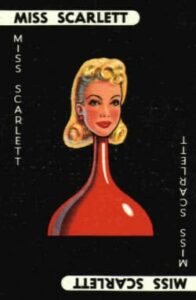
Whodunnit?
But, if it was murder, who killed Amy? The programme examined the following suspects:-
Robert Dudley
Although, at first glance, it seemed that Dudley had the most to gain from his wife’s death and therefore was the most likely killer, there is evidence in his defence – his reaction to Amy’s death, his letters to Blount, his desire for a full investigation.
Dudley’s Henchmen
Could Dudley’s henchmen have taken matters into their own hands and killed Amy for Dudley so that he could marry Elizabeth?
A contemporary account in the British Library describes how Sir Richard Verney, a retainer of Dudley, was in Cumnor on the day that Amy died and that he arranged her death. However, the programme asked if Dudley would really have tolerated one of his servants killing Amy and suggested that Dudley would have cleared his own name and stopped all of the scandal and rumour by bringing his servant to justice.
At this point, the programme asked “who would Amy clear the house of servants for?” and it was suggested that Amy would make sure the house was empty and that she was alone if she was asked to do so by her husband, her Queen or William Cecil.
Elizabeth I
Tracy Borman spoke of Elizabeth’s fiery temper and the way that she could lash out at people in anger, such as stabbing one lady in the back of the hand with a fork and breaking the finger of another lady when she married without the Queen’s permission. It was also pointed out that, according to a letter written from the Spanish ambassador to Philip II, Elizabeth had spoken of how Amy was dead or nearly so before news of Amy’s accident had reached court. Did Elizabeth know something? However, Borman argued that Elizabeth was too much of a pragmatist to involve herself in murder and that also the secret would have eventually come out.
William Cecil
Philippa Gregory spoke of her belief that William Cecil was involved in Amy’s death, that he benefited most from her death and that he made the connection between Amy’s death, Dudley’s reputation and the impossibility of Elizabeth marrying Dudley. It was pointed out that Amy’s death prevented Dudley and Elizabeth marrying and that before Amy’s death Cecil had been close to resigning but after her death his career soared. However, Chris Skidmore said that he’s not sure that William Cecil would have taken the risk of making Dudley a widower.
Kenilworth
Even though Amy’s death caused scandal and Dudley suffered as a result, he did not give up wooing Elizabeth. In 1575 he entertained the Queen at Kenilworth Castle with lavish pageants and displays, which Shakespeare alludes to in “Midsummer Night’s Dream”, and Sarah Gristwood spoke of this being “his last throw of the dice”. However, all of it was wasted on Elizabeth.
The Virgin Queen
The programme concluded by saying that Amy’s death prevented Elizabeth marrying Dudley and that it caused Elizabeth to become “The Virgin Queen”. Amy’s death, therefore, changed the course of history and ended the Tudor dynasty.
Amy’s Tomb
The programme ended with Chris Skidmore visiting Amy Robsart’s tomb in a corner of Oxford’s University Church. This is actually a memorial tablet rather than Amy’s tomb as it is not known exactly where in the church her body lies. In his article, “The Death of Amy Robsart”, Professor Ian Aird wrote:-
“The exact site of Amy’s grave has never been known, though in the contemporary account it was said to
have been at the east end of the church of St. Mary the Virgin in Oxford. In November 1946, after a fire in that church, it became necessary to re-lay the whole of the pavement of the chancel, and opportunity was then taken of exploring the area where Amy Robsart’s grave might have been expected to be. It was discovered, however, that all the area had been dug over subsequent to her burial, and some vaults of a later date were discovered, one of them, incidentally, being that of Cardinal Newman’s mother. The disturbance of the soil down to a depth of about six feet was very great and bones and soil were so intermingled and in such complete disorder that if there had been a grave in the area all trace of it was lost, destroyed by the previous disturbance. There is thus no hope now of recovering Amy Robsart’s remains and of observing the kind of broken neck which caused her death.”
My Thoughts
I cannot say that I was convinced by any of the arguments put forward by the programme as to me it just seemed like speculation and there really was no new evidence brought to light. I’ve always been torn between three theories – accident, suicide and murder by an unknown person – and I still am. Amy’s behaviour leading up to her death suggests suicide, although her faith may have prevented her from actually doing so, and the two deep head wounds suggest murder, however, I have not seen the coroner’s report and so find it difficult to come to a conclusion. What I am sure of is that Robert Dudley, Elizabeth I and William Cecil had nothing to do with her death.
What do you think?
